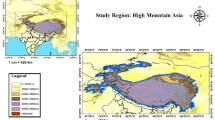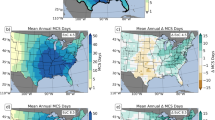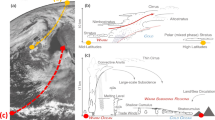Abstract
The subtropical highs are semi-permanent atmospheric features that strengthen during April–September, exerting a large influence on regional rainfall1,2,3,4,5. Previous studies have focused on the changes of subtropical highs during their peak season (June–August)6,7,8, but little is known about their changes in other seasons. Here, a suite of multi-model simulations are used to demonstrate the robust seasonally dependent responses of subtropical highs and tropical rainfall to anthropogenic warming. The zonal-mean subtropical highs in the Northern Hemisphere are shown to strengthen more during April–June than July–September, with opposite responses for the Southern Hemisphere counterparts. These responses are closely related to a southward shift of tropical rainfall in April–June relative to July–September, manifesting in a seasonal delay of tropical rainfall and monsoon onset in the Northern Hemisphere9,10. Such seasonality is found to occur in response to elevated latent energy demand in the hemisphere warming up seasonally, as dictated by the Clausius–Clapeyron relation. The interhemispheric energy contrast drives a southward shift of tropical rainfall that strengthens the Hadley cell and zonal-mean subtropical highs in the Northern Hemisphere in April–June relative to July–September. These changes scale linearly with warming, with increasing implications for projecting climate changes in the tropics and subtropics as warming continues.




Similar content being viewed by others
References
Li, W., Li, L., Fu, R., Deng, Y. & Wang, H. Changes to the North Atlantic subtropical high and its role in the intensification of summer rainfall variability in the southeastern United States. J. Clim. 24, 1499–1506 (2011).
Zhou, T. & Yu, R. Atmospheric water vapor transport associated with typical anomalous summer rainfall patterns in China. J. Geophys. Res. 110, D08104 (2005).
Colbert, A. & Soden, B. Climatological variations in North Atlantic tropical cyclone tracks. J. Clim. 25, 657–673 (2012).
Stowasser, M., Wang, Y. & Hamilton, K. Tropical cyclone changes in the western North Pacific in a global warming scenario. J. Clim. 20, 2378–2396 (2007).
Wu, L., Wang, B. & Geng, S. Growing typhoon influence on East Asia. Geophys. Res. Lett. 32, L18703 (2005).
Li, W., Li, L., Ting, M. & Liu, Y. Intensification of Northern Hemisphere subtropical highs in a warming climate. Nat. Geosci. 5, 830–834 (2012).
Shaw, T. A. & Voigt, A. Tug of war on the summertime circulation between radiative forcing and sea surface warming. Nat. Geosci. 8, 560–566 (2015).
He, C., Wu, B., Zou, L. & Zhou, T. Responses of the summertime subtropical anticyclone to global warming. J. Clim. 30, 6465–6479 (2017).
Biasutti, M. & Sobel, A. H. Delayed Sahel rainfall and global seasonal cycle in a warmer climate. Geophys. Res. Lett. 36, L23707 (2009).
Dwyer, J. G., Biasutti, M. & Sobel, A. H. The effects of greenhouse gas-induced changes in SST on the annual cycle of zonal mean tropical precipitation. J. Clim. 27, 4545–4565 (2014).
Namias, J. Influence of Northern Hemisphere general circulation on drought in northeast Brazil. Tellus 24, 336–343 (1972).
Hoskins, B. J. On the existence and intensity of summer subtropical anticyclones. Bull. Am. Meteorol. Soc. 77, 1287–1291 (1996).
Rodwell, M. J. & Hoskins, B. J. Subtropical anticyclones and summer monsoon. J. Clim. 14, 3192–3211 (2001).
Wang, B. et al. Northern Hemisphere summer monsoon intensified by mega-El Niño/southern oscillation and Atlantic multidecadal oscillation. Proc. Natl Acad. Sci. USA 110, 5347–5352 (2013).
Pathak, A., Ghosh, S., Martinez, J. A., Dominguez, F. & Kumar, P. Role of oceanic and land moisture sources and transport in the seasonal and interannual variability of summer monsoon in India. J. Clim. 30, 1839–1859 (2017).
Li, W. et al. Intensification of the Southern Hemisphere summertime subtropical anticyclones in a warming climate. Geophys. Res. Lett. 40, 5959–5964 (2013).
Taylor, K. E., Stouffer, R. J. & Meehl, G. A. An overview of CMIP5 and the experiment design. Bull. Am. Meteorol. Soc. 93, 485–498 (2012).
Held, I. M. & Soden, B. J. Robust responses of the hydrological cycle to global warming. J. Clim. 19, 5686–5699 (2006).
Chou, C., Neelin, J., Chen, C. & Tu, J. Evaluating the ‘rich-get-richer’ mechanism in tropical precipitation change under global warming. J. Clim. 22, 1982–2005 (2009).
Xie, S.-P. et al. Global warming pattern formation: sea surface temperature and rainfall. J. Clim. 23, 966–986 (2010).
Johnson, N. C. & Xie, S.-P. Changes in the sea surface temperature threshold for tropical convection. Nat. Geosci. 3, 842–845 (2010).
Huang, P., Xie, S. P., Hu, K. M., Huang, G. & Huang, R. H. Patterns of the seasonal response of tropical rainfall to global warming. Nat. Geosci. 6, 357–361 (2013).
Lindzen, R. S. & Hou, A. Y. Hadley circulations for zonally averaged heating centered off the Equator. J. Atmos. Sci. 45, 2417–2427 (1988).
Kang, S. M., Held, I. M., Frierson, D. & Zhao, M. The response of the ITCZ to extratropical thermal forcing: idealized slab-ocean experiments with a GCM. J. Clim. 21, 3521–3532 (2008).
Kang, S. M., Frierson, D. & Held, I. M. The tropical response to extratropical thermal forcing in an idealized GCM: the importance of radiative feedbacks and convective parameterization. J. Atmos. Sci. 66, 2812–2827 (2009).
Schneider, T., Bischoff, T. & Haug, G. H. Migrations and dynamics of the intertropical convergence zone. Nature 513, 45–53 (2014).
Power, S. B., Delage, F., Colman, R. & Moise, A. Consensus on twenty-first-century rainfall projections in climate models more widespread than previously thought. J. Clim. 25, 3792–3809 (2012).
Acknowledgements
This research is supported by the US Department of Energy Office of Science Biological and Environmental Research as part of the Regional and Global Climate Modeling Program. This work has benefited from discussions with Z. Feng, R. A. Houze Jr, C. He and W. Zhou. PNNL is operated for the Department of Energy by Battelle Memorial Institute under contract DE-AC05-76RL01830. We acknowledge the World Climate Research Program’s Working Group on Coupled Modeling, which is responsible for CMIP, and thank the climate modelling groups (listed in Supplementary Table 1) for producing and making available their model output. For CMIP, the US DOE’s Program for Climate Model Diagnosis and Intercomparison (PCMDI) provides coordinating support and led the development of software infrastructure in partnership with the Global Organization for Earth System Science Portals.
Author information
Authors and Affiliations
Contributions
L.R.L. and F.S. designed the research. F.S. performed the analysis alongside discussions with all other authors. F.S. and L.D. performed the theoretical derivation. J.L. contributed to improving the analysis and interpretation. F.S. wrote the first draft of this paper. All authors discussed and commented on the paper.
Corresponding authors
Ethics declarations
Competing interests
The authors declare no competing interests.
Additional information
Publisher’s note: Springer Nature remains neutral with regard to jurisdictional claims in published maps and institutional affiliations.
Supplementary information
Supplementary Information
Supplementary Table 1, Supplementary Figures 1–14
Rights and permissions
About this article
Cite this article
Song, F., Leung, L.R., Lu, J. et al. Seasonally dependent responses of subtropical highs and tropical rainfall to anthropogenic warming. Nature Clim Change 8, 787–792 (2018). https://doi.org/10.1038/s41558-018-0244-4
Received:
Accepted:
Published:
Issue Date:
DOI: https://doi.org/10.1038/s41558-018-0244-4
- Springer Nature Limited
This article is cited by
-
Robust changes in global subtropical circulation under greenhouse warming
Nature Communications (2024)
-
Significantly wetter or drier future conditions for one to two thirds of the world’s population
Nature Communications (2024)
-
Warming-induced contraction of tropical convection delays and reduces tropical cyclone formation
Nature Communications (2023)
-
Strengthening atmospheric circulation and trade winds slowed tropical Pacific surface warming
Communications Earth & Environment (2023)
-
Seasonal advance of intense tropical cyclones in a warming climate
Nature (2023)





